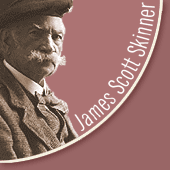




James Scott Skinner – The Other Collections
Harp and Claymore Collection · JSS Other Collections · Discography
First compositions
The ‘Highland Polka’, published when he was 17, was the first of more than 600 compositions by James Scott Skinner. Many of his early compositions were connected with his work as a dancing-master, composed to suit the popular ballroom dances he taught in his classes. His first set of quadrilles, ‘The Ettrick Vale Quadrilles’ (JSS0666 – JSS0674), were published in 1863, the year he started teaching. He also taught, and composed music for Quadrille Lancers, Galops, Waltzes and Polkas. As well as ballroom dances, he also wrote Strathspeys and Reels, which he could also use in his dance classes.
Performance
Skinner was also thinking about performance. By the time he moved to the Elgin area, around 1871, he was playing the fiddle in concerts all over the north east of Scotland. He usually performed with his brother Sandy and other local musicians. Concert programmes show that audiences were entertained with light ‘classical’ music more often than with Skinner’s own Scottish selections.
Ballroom Dances
We have included some examples of his ballroom music, such as The Election Galop (JSS0765 – JSS0769). Although a delightful composition, it is more reminiscent of the Viennese ballroom and compositions by the Strauss family. By comparison, the ‘Northern Meeting Quadrilles’, also for the ballroom, sounded decidedly Scottish. The ballroom compositions were published as singly as sheet music although Skinner collected some of them together under the title, ‘Beauties of the Ballroom’ (1884).
James Scott Skinner’s best known collections are:
- The Miller o’ Hirn Collection (1881), a successful compilation of Scottish dance music, songs and airs, all of his own composition. We have included some examples (JSS0718 – JSS0742). By this time he had started to write in the bagpipe idiom. Many melodies are dedicated to people he knew: The Miller o’ Hirn, his wife and son, (JSS0723, JSS0739, JSS0726); Professor Scott (JSS0742); other patrons and places. Skinner often included a little information about the subject underneath the title.
- The Elgin Collection (1884) was planned in 4 parts but only the first was ever published. A very popular collection, it was reprinted more than once. JSS0743 – JSS0755 provide some examples.
- The Logie Collection (1888), (JSS0779 – JSS0821). The first collection published after his bankruptcy. Skinner included a number of songs. There were certain poets that Skinner admired, including his friend Gramin (George Gordon Ingram), and La Teste (William Tester). He invited them to set their poems to his music. The music was always written first.
- The Scottish Violinist (1900) which was a ‘compilation album’ and unlike the others, published for unaccompanied solo violin.
- The Harp and Claymore Collection (1904).
We have also included examples from a Scrapbook Skinner compiled and presented to Mrs Barclay of Keith. A strathspey, ‘Good Morning Mrs Barclay’ (JSS0795) appears in the Logie Collection). In the Scrapbook, Skinner has sketched in very simple basses to accompany his tunes.
The collections are fascinating. Although Skinner produced some wonderful tunes, he also produced many mediocre pieces. This is to be expected – he did compose more than 600 tunes. Some of the reels, for example, are very alike, almost formulaic. Skinner even said that he did not play many of his tunes at concerts, as he considered them to be mere ‘pot-boilers’ and not worthy of his attention!
Pat Ballantyne


Historic
Collections · Kings College · Old
Aberdeen · AB24 3SW
Tel:(0)44 1224 274312 · E-mail: scottskinner@abdn.ac.uk